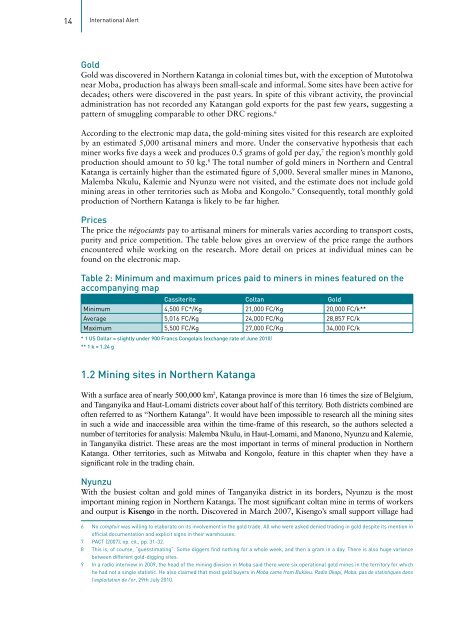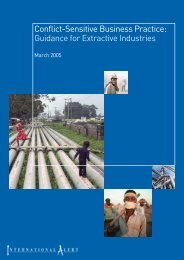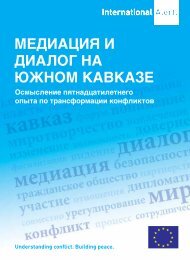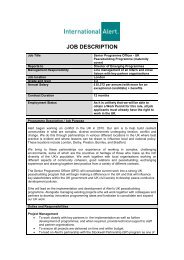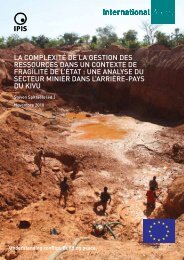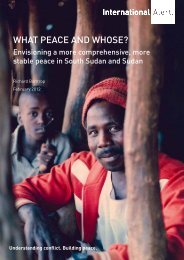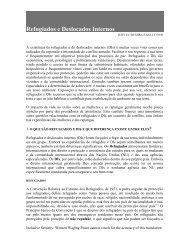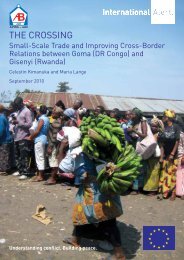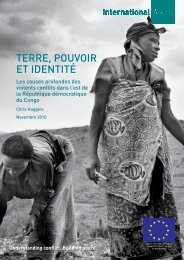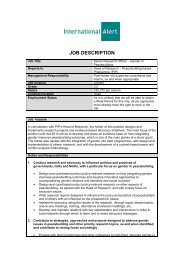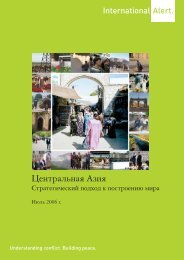The complexiTy of resource governance in a conTexT of sTaTe ... - Ipis
The complexiTy of resource governance in a conTexT of sTaTe ... - Ipis
The complexiTy of resource governance in a conTexT of sTaTe ... - Ipis
Create successful ePaper yourself
Turn your PDF publications into a flip-book with our unique Google optimized e-Paper software.
14 International Alert<br />
Gold<br />
Gold was discovered <strong>in</strong> Northern Katanga <strong>in</strong> colonial times but, with the exception <strong>of</strong> Mutotolwa<br />
near Moba, production has always been small-scale and <strong>in</strong>formal. Some sites have been active for<br />
decades; others were discovered <strong>in</strong> the past years. In spite <strong>of</strong> this vibrant activity, the prov<strong>in</strong>cial<br />
adm<strong>in</strong>istration has not recorded any Katangan gold exports for the past few years, suggest<strong>in</strong>g a<br />
pattern <strong>of</strong> smuggl<strong>in</strong>g comparable to other DRC regions. 6<br />
Accord<strong>in</strong>g to the electronic map data, the gold-m<strong>in</strong><strong>in</strong>g sites visited for this research are exploited<br />
by an estimated 5,000 artisanal m<strong>in</strong>ers and more. Under the conservative hypothesis that each<br />
m<strong>in</strong>er works five days a week and produces 0.5 grams <strong>of</strong> gold per day, 7 the region’s monthly gold<br />
production should amount to 50 kg. 8 <strong>The</strong> total number <strong>of</strong> gold m<strong>in</strong>ers <strong>in</strong> Northern and Central<br />
Katanga is certa<strong>in</strong>ly higher than the estimated figure <strong>of</strong> 5,000. Several smaller m<strong>in</strong>es <strong>in</strong> Manono,<br />
Malemba Nkulu, Kalemie and Nyunzu were not visited, and the estimate does not <strong>in</strong>clude gold<br />
m<strong>in</strong><strong>in</strong>g areas <strong>in</strong> other territories such as Moba and Kongolo. 9 Consequently, total monthly gold<br />
production <strong>of</strong> Northern Katanga is likely to be far higher.<br />
Prices<br />
<strong>The</strong> price the négociants pay to artisanal m<strong>in</strong>ers for m<strong>in</strong>erals varies accord<strong>in</strong>g to transport costs,<br />
purity and price competition. <strong>The</strong> table below gives an overview <strong>of</strong> the price range the authors<br />
encountered while work<strong>in</strong>g on the research. More detail on prices at <strong>in</strong>dividual m<strong>in</strong>es can be<br />
found on the electronic map.<br />
Table 2: M<strong>in</strong>imum and maximum prices paid to m<strong>in</strong>ers <strong>in</strong> m<strong>in</strong>es featured on the<br />
accompany<strong>in</strong>g map<br />
Cassiterite Coltan Gold<br />
M<strong>in</strong>imum 4,500 FC*/Kg 21,000 FC/Kg 20,000 FC/k**<br />
Average 5,016 FC/Kg 24,000 FC/Kg 28,857 FC/k<br />
Maximum 5,500 FC/Kg 27,000 FC/Kg 34,000 FC/k<br />
* 1 US Dollar = slightly under 900 Francs Congolais (exchange rate <strong>of</strong> June 2010)<br />
** 1 k = 1.24 g<br />
1.2 M<strong>in</strong><strong>in</strong>g sites <strong>in</strong> Northern Katanga<br />
With a surface area <strong>of</strong> nearly 500,000 km 2 , Katanga prov<strong>in</strong>ce is more than 16 times the size <strong>of</strong> Belgium,<br />
and Tanganyika and Haut-Lomami districts cover about half <strong>of</strong> this territory. Both districts comb<strong>in</strong>ed are<br />
<strong>of</strong>ten referred to as “Northern Katanga”. It would have been impossible to research all the m<strong>in</strong><strong>in</strong>g sites<br />
<strong>in</strong> such a wide and <strong>in</strong>accessible area with<strong>in</strong> the time-frame <strong>of</strong> this research, so the authors selected a<br />
number <strong>of</strong> territories for analysis: Malemba Nkulu, <strong>in</strong> Haut-Lomami, and Manono, Nyunzu and Kalemie,<br />
<strong>in</strong> Tanganyika district. <strong>The</strong>se areas are the most important <strong>in</strong> terms <strong>of</strong> m<strong>in</strong>eral production <strong>in</strong> Northern<br />
Katanga. Other territories, such as Mitwaba and Kongolo, feature <strong>in</strong> this chapter when they have a<br />
significant role <strong>in</strong> the trad<strong>in</strong>g cha<strong>in</strong>.<br />
Nyunzu<br />
With the busiest coltan and gold m<strong>in</strong>es <strong>of</strong> Tanganyika district <strong>in</strong> its borders, Nyunzu is the most<br />
important m<strong>in</strong><strong>in</strong>g region <strong>in</strong> Northern Katanga. <strong>The</strong> most significant coltan m<strong>in</strong>e <strong>in</strong> terms <strong>of</strong> workers<br />
and output is Kisengo <strong>in</strong> the north. Discovered <strong>in</strong> March 2007, Kisengo’s small support village had<br />
6 No comptoir was will<strong>in</strong>g to elaborate on its <strong>in</strong>volvement <strong>in</strong> the gold trade. All who were asked denied trad<strong>in</strong>g <strong>in</strong> gold despite its mention <strong>in</strong><br />
<strong>of</strong>ficial documentation and explicit signs <strong>in</strong> their warehouses.<br />
7 PACT (2007), op. cit., pp. 31-32.<br />
8 This is, <strong>of</strong> course, “guesstimat<strong>in</strong>g”. Some diggers f<strong>in</strong>d noth<strong>in</strong>g for a whole week, and then a gram <strong>in</strong> a day. <strong>The</strong>re is also huge variance<br />
between different gold-digg<strong>in</strong>g sites.<br />
9 In a radio <strong>in</strong>terview <strong>in</strong> 2009, the head <strong>of</strong> the m<strong>in</strong><strong>in</strong>g division <strong>in</strong> Moba said there were six operational gold m<strong>in</strong>es <strong>in</strong> the territory for which<br />
he had not a s<strong>in</strong>gle statistic. He also claimed that most gold buyers <strong>in</strong> Moba came from Bukavu. Radio Okapi, Moba: pas de statistiques dans<br />
l’exploitation de l’or, 29th July 2010.


